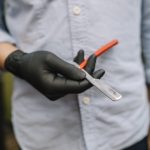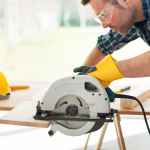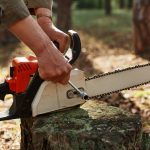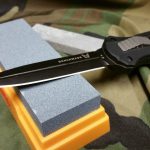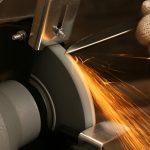When you’re a professional barber, your tools are an extension of your skills. A pair of dull clippers can turn a clean cut into a frustrating experience—for both you and your client. That’s why clipper blade sharpening is not just routine maintenance; it’s an essential part of delivering top-tier grooming services. In this post, we’ll cover practical tips and best practices to keep your clipper blades razor sharp, ensuring precision, safety, and efficiency in every cut.
Why Clipper Blade Sharpening Matters
The sharpness of your clipper blades directly affects your performance. Dull blades can pull hair, cause uneven cuts, and even lead to irritation or injury for your clients. Worse, they can damage the clippers themselves if overworked. Regular clipper blade sharpening ensures:
- Cleaner, smoother cuts
- Improved client comfort
- Longer lifespan for your equipment
- Reduced strain on your clippers’ motor
In short, sharp blades protect your investment and your reputation.
Signs Your Clipper Blades Need Sharpening
Many barbers wait too long before servicing their clippers. Watch for these common signs:
- Tugging or pulling hair: The blade no longer glides effortlessly.
- Noisy operation: Dull blades often cause clippers to vibrate or sound strained.
- Overheating: If your clippers are running hotter than usual, the blades may be working harder than they should.
- Uneven cuts or missed patches: Sharp blades provide consistency across every stroke.
- Visual dullness: A close look at the blade edge may show rounding or nicks.
Paying attention to these indicators helps you avoid performance dips and potential damage.
How Often Should You Sharpen Clipper Blades?
There’s no one-size-fits-all answer—it depends on how often you use them and how well you maintain them. For full-time barbers:
- Professional sharpening is typically needed every 1–3 months.
- Light users may stretch it to 4–6 months.
- High-volume shops might benefit from more frequent sharpening, perhaps even monthly.
Regular oiling and cleaning can help extend the time between sharpenings, but they won’t replace it.
Clipper Blade Sharpening: DIY or Professional?
When it comes to clipper blade sharpening, you have two main options: do it yourself or hire a professional.
DIY Sharpening
You can purchase sharpening stones or honing machines specifically made for clipper blades. The process involves:
- Disassembling the blade carefully.
- Cleaning off old hair, oil, and debris.
- Running the blade against the stone at the correct angle.
- Testing and reassembling to ensure performance.
Pros:
- Cost-effective over time
- Convenient if you’re confident and experienced
Cons:
- Risk of damaging the blade if done incorrectly
- Time-consuming
- Doesn’t always restore factory-level sharpness
Professional Sharpening Services
A professional clipper blade sharpening service uses specialized equipment to restore blades to like-new condition. They’ll also check for alignment and blade tension.
Pros:
- Precision results
- Less risk of blade damage
- Time-saving for busy professionals
Cons:
- Slightly more expensive
- Requires sending or dropping off blades
If you value reliability and precision, professional sharpening is a smart choice.
Daily Maintenance Tips to Prolong Sharpness
While sharpening is crucial, daily care plays a big role in keeping your clipper blades performing at their best. Here are key habits to follow:
1. Clean After Every Use
Hair and product residue can dull blades quickly. Use a small brush or compressed air to remove buildup. Follow up with disinfectant spray to maintain hygiene.
2. Oil Regularly
Apply a drop of clipper oil to the blade teeth and sides before each use. This reduces friction and prevents heat buildup, both of which preserve blade sharpness.
3. Store Properly
Avoid tossing clippers into a drawer. Use blade guards and store them in a clean, dry place to prevent accidental drops and corrosion.
4. Check Blade Alignment
Misaligned blades can cause cuts or uneven trimming. Regularly inspect the blade position and adjust as needed.
5. Don’t Cut Dirty or Wet Hair
Wet or dirty hair adds stress to your blades and can lead to quicker dulling. Always ensure hair is clean and dry before cutting.
Choosing the Right Clipper Blade Sharpening Service
If you’re looking for a reliable sharpening service, consider these factors:
- Experience with barber tools: Look for specialists who regularly sharpen clipper blades, not just general knife or scissor services.
- Turnaround time: Fast service helps reduce downtime in your business.
- Reputation and reviews: Positive feedback from other barbers is a good sign.
- Cost: It should be competitive, but remember: cheap work can sometimes mean low quality.
Some sharpening services even offer mail-in options, so you can get your blades serviced without leaving your shop.
Final Thoughts
Keeping your clipper blades sharp is more than a maintenance task—it’s a critical part of your craft. Whether you choose to sharpen them yourself or trust a professional clipper blade sharpening service, staying on top of blade care ensures smoother cuts, safer trims, and happier clients.
In the long run, investing time and attention into your tools pays off with consistent quality, improved performance, and a reputation for excellence. Don’t let dull blades dull your edge—keep them razor sharp and ready for action.


